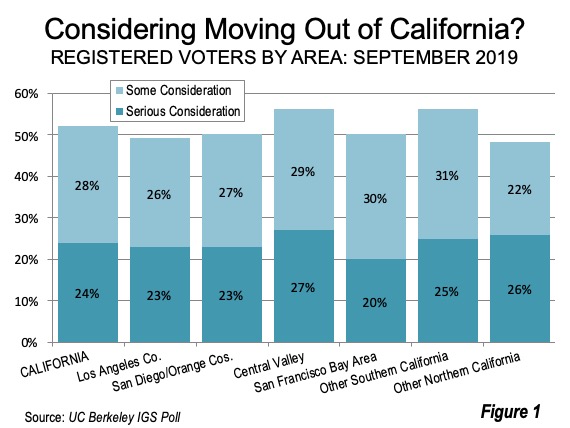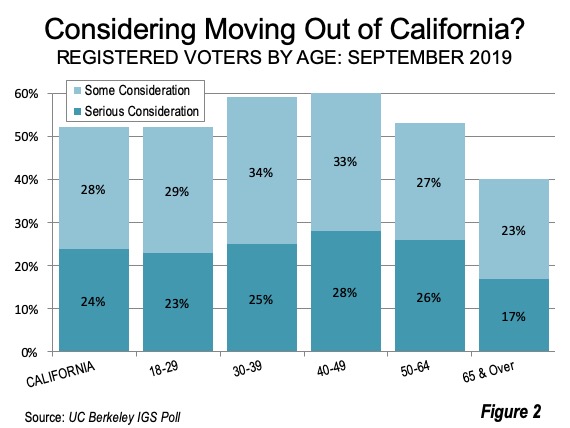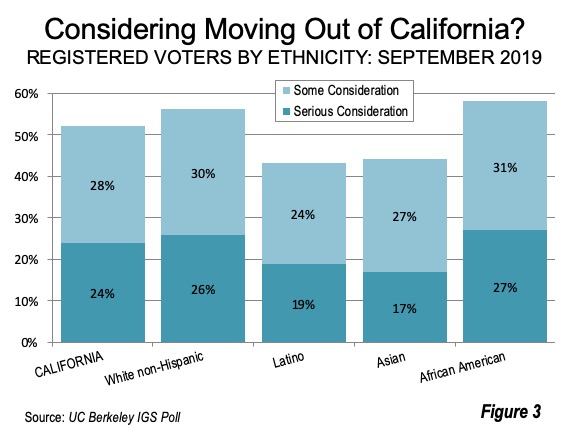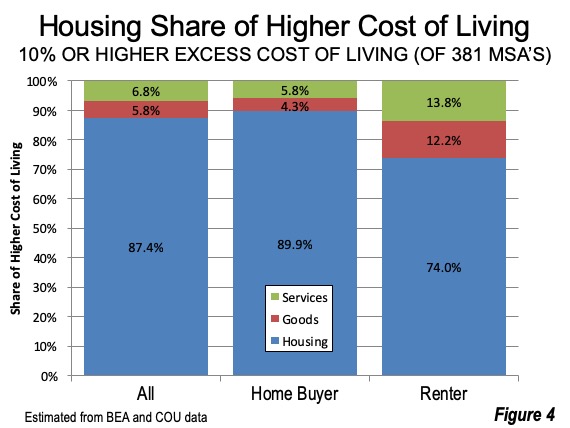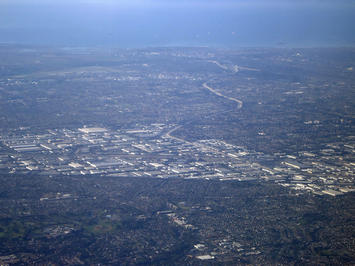
For virtually all of its history from statehood in 1850 to 2000, California was a magnet drawing households from the rest of the United States for better lives. Indeed, in a nation that had its "American Dream," California had its own "California Dream." There was no Oregon dream, despite its mountains , seashore and proximity to California, nor was there a Maine or South Carolina dream.
And while California remains incomparable with respect to weather and access to beaches and mountains, the allure of the "California Dream" has faded significantly. Probably nothing demonstrates this more convincingly than the fact that since 2000, 2.2 million more residents have moved out to other states than in.
University of California Poll
A new University of California Berkeley IGS Poll indicates that many others are considering leaving the state. The poll was conducted in mid-September from a random sample of about 4500 registered voters. More than half of California's registered voters are giving serious consideration or some consideration to leaving the state. This includes 24% giving serious consideration and 28% giving some consideration.
Areas of the State
The poll divided the state into six areas but the results were fairly consistent. The core of the state's largest urbanization, Los Angeles County just under half (49%) are considering leaving the state. To the south, Orange and San Diego counties were combined in the analysis and their 50% of the households are considering leaving. The rest of Southern California, 56% of the households are considering moving out of the state. This area, dominated by a metropolitan area, Riverside – San Bernardino, is almost as large populous as metropolitan San Francisco and is the fastest growing major metropolitan area in the state.
Residents of the Central Valley exceeded the unhappiness level of the rest of Southern California, with 56% considering a move out of the state. The Central Valley had been growing faster than the rest of the state during the last decade, but considerably less than the previous decade.
Much of the state's economic growth has occurred during this decade in the San Francisco Bay area, which includes the San Francisco and San Jose metropolitan areas. Yet even in this area, indisputably the world's leading tech center, half of the residents (50%) are considering moving out of the state. The rest of Northern California, has the least unhappy households, with only 46% considering an interstate move (Figure 1). Of course, this was before PG&E cut off electricity to much of the area.
Age
There is more variation on intentions to move by age than by area, concentrated among those in the period of family formation and home-buying. Among households in the 40 to 49 category, 61% are considering a move out of the state while households in the 30 to 39 age group are 59% inclined to consider an interstate move. Among those aged 50 to 64, 53% are considering a move out of the state.
The only group where a majority intends to stay is those aged 65 or older, with only 40% considering a move out. This smaller number may be influenced to a great extent by this age group's ability to buy homes at at the much lower prices that prevailed before, The only group where a majority is staying put are those aged 65 or older. The youngest category, 18 to 29 , often an age before home buying and family formation, mirrors the statewide average, with 52% considering a move to another state (Figure 2).
Race and Ethnicity
The Berkeley IGS Poll also categorized responders by race and ethnicity. The most satisfied have been Latinos, 43% of whom indicated an interest in leaving the state. Asian scored similarly, with 44% while 56% of White non—Hispanics were considering an out-of-state move. The greatest dissatisfaction was indicated by African – Americans, 58% of whom are considering moving out. These last two figures are consistent with declining population shares. As late as 1980, white non—Hispanics were the largest ethnic group in the state and rank second now to Hispanics. African-Americans were the second largest ethnic group and now ranked fourth after Hispanics, White non—Hispanics and Asians (Figure 3).
African-Americans and White non-Hispanics both have majorities favoring a move out. The numbers are somewhat smaller with respect to the ethnicities that have increased most substantially in recent decades --- Hispanics and Asians. However, even among these ethnicities there is reason for concern, with more than 40 percent thinking of leaving.
Why Californians Want to Leave
California has long had the least affordable housing costs in the nation, which translate into the highest cost of living. Nearly all of the difference in cost of living between higher cost areas and the national average stems from housing (Figure 4). Not surprisingly, the top reason for wanting to leave was the high cost of housing, which was mentioned by 71% of respondents. High taxes were mentioned by 58% of respondents, and the state's political culture 47% . The poll generally found that more conservative people (as opposed to more liberal people) were more likely to consider moving.
Overcrowding was mentioned by 38% of the respondents. This is likely to become an even greater concern, since California's highest urban density in the nation is likely to be materially increased by state densification policies (Figure 5).
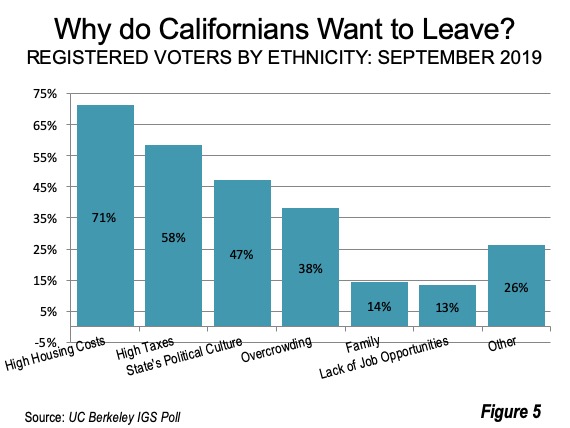
Things Could Get Worse
These reasons for leaving do not bode well for California. There is no indication that things will get better for potential leavers.
Housing costs are severely unaffordable and likely to get no better: Demographia International Housing Affordability Survey.
California's high taxes are not likely to be reduced. More likely they will continue to increase.
It is not surprising that people are concerned about overcrowding. California has the densest urbanization among the 50 states and strong densification mandates from the state likely to increase overcrowding. (see: "America's Most Urban States"). Largely as a result, California has the two most overcrowded metropolitan road systems (Los Angeles and San Francisco) in the nation as public officials pretend (largely innocently) that transit is an alternative to driving more than a few. Even so, the state is committed to even more densification, which promises to exacerbate the overcrowding, and make traffic congestion even worse.
California retains its great weather and beautiful scenery, but its status as America's dreamland has been shattered by the exiting millions.
Photograph: Outer suburbs of Los Angeles (western San Bernardino County), by author.
Wendell Cox is principal of Demographia, an international public policy and demographics firm. He is a Senior Fellow of the Center for Opportunity Urbanism (US), Senior Fellow for Housing Affordability and Municipal Policy for the Frontier Centre for Public Policy (Canada), and a member of the Board of Advisors of the Center for Demographics and Policy at Chapman University (California). He is co-author of the "Demographia International Housing Affordability Survey" and author of "Demographia World Urban Areas" and "War on the Dream: How Anti-Sprawl Policy Threatens the Quality of Life." He was appointed by Mayor Tom Bradley to three terms on the Los Angeles County Transportation Commission, where he served with the leading city and county leadership as the only non-elected member. Speaker of the House of Representatives appointed him to the Amtrak Reform Council. He served as a visiting professor at the Conservatoire National des Arts et Metiers, a national university in Paris.
